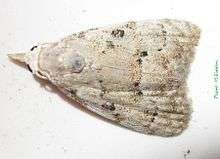Carposinidae
| Carposinidae | |
|---|---|
 | |
| Scopalostoma melanoparea | |
| Scientific classification | |
| Kingdom: | Animalia |
| Phylum: | Arthropoda |
| Class: | Insecta |
| Order: | Lepidoptera |
| Suborder: | Glossata |
| Infraorder: | Heteroneura |
| (unranked): | Ditrysia |
| Superfamily: | Copromorphoidea |
| Family: | Carposinidae (Walsingham, 1907) |
| Genus | |
| |
| Diversity | |
| About 273 species | |
Carposinidae, the "fruitworm moths" is a family of insects in the lepidopteran order. These moths are narrower winged than Copromorphidae, with less rounded forewing tips. Males often have conspicuous patches of scales on either surface (Dugdale et al., 1999). The mouthparts are quite diagnostic, usually with prominent, upcurved "labial palps", the third segment long (especially in females), and the second segment covered in large scales. Unlike Copromorphidae, the "M2" and sometimes "M1" vein on the hindwings is absent. The relationship of Carposinidae relative to Copromorphidae needs further investigation. It is considered possible that the family is artificial, being nested within Copromorphidae (Dugdale et al., 1999). The Palearctic species have been revised by Diakonoff (1989).
Distribution
Carposinidae occur worldwide except the NW Palearctic region (Dugdale et al., 1999)..
Behaviour
Adults are greenish or greyish, with camouflage patterns, night-flying and attracted to lights. Caterpillars live within leaves, flowers, fruits or buds, or also in galls within plant tissue. The larvae pupate with the larval shelter or descend to the ground and make a cocoon covered in detritus (Dugdale et al., 1999)..
Larval hostplants
The caterpillars feed on the gymnosperm family Podocarpaceae as well as the dicotyledon plant families Asteraceae, Campanulaceae, Ericaceae, Fagaceae, Myrtaceae, Rosaceae, Proteaceae and Rutaceae (Dugdale et al., 1999). As the moths can infest fruit some are considered pest species such as the "Peach Fruit Moth".[1]
General references
- Davis, D.R. (1968). A revision of the American moths of the family Carposinidae (Lepidoptera: Carposinoidea). Bulletin of the United States National Museum 289: 1–105.
- Diakonoff, A., (1989). Revision of the Palaearctic Carposinidae with description of a new genus and new species (Lepidoptera: Pyraloidea). Zoölogische Verhandelingen. 251: 1–155.
- Dugdale, J.S., Kristensen, N.P., Robinson, G.S. and Scoble, M.J. (1999) [1998]. The smaller microlepidoptera grade superfamilies, Ch.13., pp. 217–232 in Kristensen, N.P. (Ed.). Lepidoptera, Moths and Butterflies. Volume 1: Evolution, Systematics, and Biogeography. Handbuch der Zoologie. Eine Naturgeschichte der Stämme des Tierreiches / Handbook of Zoology. A Natural History of the phyla of the Animal Kingdom. Band / Volume IV Arthropoda: Insecta Teilband / Part 35: 491 pp. Walter de Gruyter, Berlin, New York.
References
- ↑ "peach fruit moth (Carposina niponensis ) on paradise apple (Malus pumila ) - 0660053". Invasive.org. Retrieved 2011-12-19.
External links
- Tree of Life
- NHM Lepindex
- Fauna Europaea Experts
- Lepidoptera of Tasmania
- Chinese Carposinidae
- Heterogyma ochrogamma
- Ctenarchis pdf
| Wikispecies has information related to: Carposinidae |